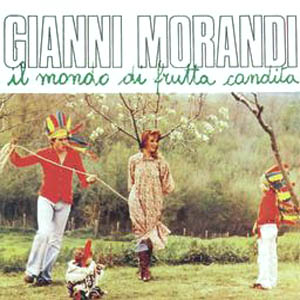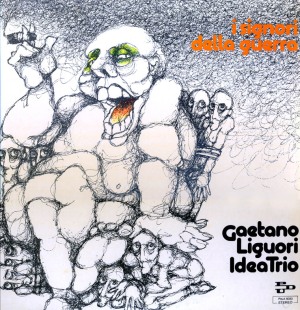Posts Tagged ‘1975’
[music:] Gianni Morandi, Il mondo di frutta candita (1975)

A kind of an identity disorder struck most of the Sixties’ teenage monstre popstars once entered the following decade, forced to face the evolution in young people’s music taste and the rise of rock bands, progressive, and cantautori.
Caught in this middle-age crisis, in the early Seventies Gianni Morandi was staggering between faint attempts to sound a bit more updated in music and engaged in lyrics, badly reviewed experiments in theatre and musicals, and fruitless efforts to win back his past success, when he decided to record a song written by Oscar Prudente and Mogol and already released as a single by Prudente in 1971: “Il mondo di frutta candita” (“the candied fruit world”), and everything suddenly seemed to fall in its place. An entire new album was built around this track, featuring the same Prudente and the young Ivano Fossati as songwriters.
You can feel his excitement and his trust and commitment in the project by the way he took over the songs with a yet unheard hoarse and almost raging voice, blessing overlooked jewels such as “Autostrade, no!”, “Io vado a sud” or “Io domani me ne vado” (just listen to this last one, and then consider that “Amarsi un po'” by Lucio Battisti will come two years later, in 1977). A promotional movie was also shot in the States to help launching the record (watch an excerpt here). And, guess what? Il mondo di frutta candita came basically unnoticed, worsening his crisis with the most bitter disappointment.
Here is the tracklist:
01, La caccia al bisonte (“the buffalo hunt”)
02, Sette di sera (“seven in the evening”)
03, Autostrade, no! (“highways, no!”)
04, Favole di mare (“sea fables”)
05, Il mondo di frutta candita (“the candied fruit world” also released as a 7″ b/w “La caccia al bisonte”)
06, Io vado a sud (“i’m going south”)
07, Due ore di polvere (“two hours of dust”)
08, Io domani me ne vado (“tomorrow i’m going away”)
09, La mia gente (“my people”)
Get it: Gianni Morandi, Il mondo di frutta candita (1975)
Anyway, this sad story came to a happy ending: after a three-years retirement from the music business, during which he studied double bass at Santa Cecilia conservatory in Rome, Gianni Morandi managed to hit the charts again in 1980, just to stay there.
He has released more than thirty albums to date, and is still one of the most popular pop singer in Italy. You can find more info on his official site MorandiMania (in Italian).
[music:] Gaetano Liguori Idea Trio, I signori della guerra (1975)

Back in the Seventies the existence – and the significance – of a politically engaged, militant jazz could have been pretty obvious in the States, or Africa, or elsewhere outside Italy, but certainly not here, where traditionalist and stiff connoisseurs audiences regarded it rather as a wicked contamination with earthly matters.
Gaetano Liguori – a classicaly trained pianist and composer – was among the first italian jazz musicians to address directly “the heavy human condition of destitutes, deviants and oppressed people at every latitude”, as this record’s liner notes read, bringing jazz to the revolutionary masses by playing thousands of gigs at factories, schools, universities, squatted places and pop festivals.
I signori della guerra (“the lords of war”), credited to his Idea Trio, came after their controversial debut album Cile libero, Cile rosso (“free Chile, red Chile”), and kept on the same path, combining free outbursts with quieter and atmospheric piano tunes and folk hints. The combo featured Filippo Monico on drums and Roberto Del Piano on bass.
Here is the tracklist:
01, I signori della guerra
02, Garabongo
03, Don Mario blues (“father Mario blues”)
04, Tarantella del vibrione (“vibrio’s tarantella” – in 1973 a huge cholera epidemic hit Naples and other cities in Southern Italy, but the track is actually dedicated to Roberto Franceschi, a 21-year old student shot dead by the police in Milan during a demonstration on January 23rd, 1973)
05, Inco
06, Viva la Cassa del Mezzogiorno (“up with the Cassa del Mezzogiorno” – Cassa del Mezzogiorno, “Mezzogiorno’s bank”, was a publicly held bank established in the Seventies to finance development projects in Southern Italy, soon infiltrated by mobsters)
Get it: Gaetano Liguori Idea Trio, I signori della guerra (1975)
In 1976 Liguori recorded, together with the poet-worker Giulio Stocchi, Demetrio Stratos, his father Pasquale Liguori on drums and some other fellow musicians La cantata rossa per Tall El Zataar (“the red cantata for Tall El Zaatar”), which recalled the huge massacre of Palestinian refugees by the hand of christian phalangists happened in Eastern Beirut earlier that year.
A version of “Tarantella del vibrione” featuring Tullio De Piscopo on drums and recorded at the Demetrio Stratos’ tribute concert in Milan, June 6th, 1979, is available in the legendary 1979 il concerto Cramps live album.
He is still active as a composer and performer. You can learn more about his past and current work at his official website (in italian only).
[music:] Roberto Cacciapaglia, Sonanze (1975)

[edit February 16th, 2009: that’s an interesting case of synchronicity – whatever. I just noticed that Jim at Mutant Sounds released a download link for this long-time lost record a couple of hours before I clicked the “Publish” button for this post. Check out their version too, with huge front/back cover pics, and a different rip encoding.]
Cosmic joker nel blu dipinto di blu. Or: mediterranEurock. It’s not by chance, indeed, that this time the Couriers’ spacecraft is a flying marranzano (the italian for jew’s harp) floating on the cover. After all, there aren’t much italian musicians who had the chance to work at first hand with german krautrock gurus – the only other names which come to my mind are Baffo Banfi from Biglietto per l’inferno, who had a couple of solo albums produced by Klaus Schulze between 1979 and 1981, and Gianna Nannini teaming up with Conny Plank from 1982 until the latter’s death in 1987 for a series of europewide successful records, with Jaki Liebezeit from Can as a session drummer.
In 1974, when Roberto Cacciapaglia entered the studio with Ohr Records founder and cosmic rock éminence grise Rolf Ulrich Kaiser, he was mostly known as the guy who sat behind the keyboards for Battiato’s second album Pollution. Actually, the music which resulted from these sessions – edited and released as Sonanze (“sonances”) the following year – was more or less related with Battiato’s early Seventies works, and somehow recalled the coeval explorations of major kosmische achievers such as Popol Vuh, Tangerine Dream or the same Schulze; neverthless, it retained something unique and inherently personal: a peculiar upward structure, an esthetical rectitude, an almost classical composure which placed it out of the space/acid rock canon, and was likely to be an heritage of Cacciapaglia’s academic training as a composer (he graduated at Milan’s “Giuseppe Verdi” conservatory before joining the phonology research team at RAI – the italian national broadcasting system – and working with the CNR – “national resarch centre” – in Pisa).
To strengthen this impression, we’re having a complete orchestra here gliding its way into the stratosphere by drones and blows, which refer to early XX century atonal tradition, while the manipulation of processed vocals (such as in the 2nd Movement) anticipated the monomanic, mesmerizing Tail of the Tiger by Roberto Laneri’s Prima Materia, providing some gusts of high solar wind. When it comes to post-impressionistic/minimal piano patterns, then, such as in the 3rd Movement, there you find yourself effortlessy climbing a spiral staircase to the stars.
Here is the tracklist:
01, 1st Movement
02, 2nd Movement
03, 3rd Movement
04, 4th Movement
05, 5th Movement
06, 6th Movement
07, 7th Movement
08, 8th Movement
09, 9th Movement
10, 10th Movement
Get it: Roberto Cacciapaglia, Sonanze (1975)
After the exploit of Sonanze (oddly released in Italy through PDU, the label founded by Mina and Augusto Martelli), Roberto Cacciapaglia went on experimenting with contemporary classic music and electronics, studying ancient sacred music and the non-musical power of sound and performing with the most diverse artists and in all kind of environments.
He also worked in the pop music industry as a refined and innovative arranger and producer for the model/actress/singer Ann Steel (in the legendary Ann Steel Album, 1979), Gianna Nannini (G.N., 1981), Giuni Russo (Vox, 1983), Ivan Cattaneo (Bandiera Gialla – “yellow flag” – 1983), Alice (Gioielli rubati – “stolen jewels”, a collection of Franco Battiato’s covers – 1985), and is a successful author of music for commercials.
His most recent effort is Canone degli spazi (“canon of the spaces”), recorded with the London Philarmonic Orchestra and released in January, 2009. You can visit his official website (also in english) for more detailed info.
[requests, music:] Ultima spiaggia, Disco dell’angoscia (1975)

Since many of you requested it, possibly time has come to make available this unidentified sound object swerving between musique concrète, pop, avant-garde, beat, rock’n’roll, old-fashioned melodies, progressive rock, which we already spoke of some months ago, in the post about Ricky Gianco’s Alla mia mam…: like continuously switching over the stations of a radio tuned on the distorted brainwaves of a man fallen in a coma after a car accident, who confusingly dreams of the Inquisition, of concentration camps, of war, torture, chain work, love, sex, painfully recovering splinters of his memory. Practically, the soundtrack of a nightmare. After all, it’s not called Disco dell’angoscia (“anguish record”) by chance.
But what really makes this record haunting and creepy to such extent is perhaps an immoderate and unreasonable expenditure, a raging emptiness hardly restrained, an extraordinary taste for bad taste, a morbid irony which results, for instance, in a children choir singing a nazi song, or a gloomy samba which cites Auschwitz.
Here is the tracklist:
01, L’incidente (“the accident”)
02, Voglio vivere (“i want to live”)
03, Motivo angoscia 1 (La religione e la morte) (“anguish theme 1 (religion and death)”)
04, Canto delle streghe e del demonio (“chant of the witches and the devil”)
05, Motivo angoscia 2 (Canto nazista) (“anguish theme 2 (nazi chant)”)
06, Samba della tortura e della guerra (“samba of torture and war”)
07, Che cosa è? (“what is it?”)
08, Motivo angoscia 3 (“anguish theme 3”)
09, Rock della ricostruzione (“reconstruction rock”)
10, Davanti al nastro che corre (“in front of the conveyor belt”)
11, Motivo angoscia 4 (“anguish theme 4”)
12, Zucchero mio (“sugar of mine”)
13, Piacere e potere (“pleasure and power”)
14, Motivo angoscia 5 (“anguish theme 5”)
15, L’incidente (“the accident”)
Get it: Ultima spiaggia, Disco dell’angoscia (1975)
The complete lineup counts – apart from Ricky Gianco (guitar, vocals), Gianfranco Manfredi and Ivan Cattaneo (vocals), Tullio De Piscopo and Ellade Bandini (drums) – Nanni Ricordi and Ninni Carucci on the vocals (the latter being a singer/songwriter which released an album through the label Ultima spiaggia in 1975, now a successful cartoon music author), Sergio Farina (guitar), Claudio Bonechi (keys), Hugo Heredia (sax), Gigi Cappellotto (bass).
